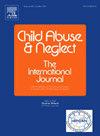青少年社交媒体用户中基于图像的性虐待与儿童时期心理健康之间的联系
IF 3.4
2区 心理学
Q1 FAMILY STUDIES
引用次数: 0
摘要
背景:基于图像的性虐待(IBSA)涉及通过制作、传播和滥用露骨图像对儿童造成的伤害。IBSA包括成人和其他青少年制作、分享和滥用露点图像的场景。目的研究独立于儿童性虐待和逆境的IBSA对18岁前吸毒过量、自杀未遂和自残的影响,重点关注性少数群体和性别少数群体青年。参与者和背景:来自美国各地的18至28岁的年轻社交媒体用户(n = 2630)。方法通过社交媒体招募参与者,完成在线调查。数据是横断面的——要求年轻人回顾18岁之前的经历。数据收集于2024年2月27日至2024年4月1日。结果sibsa与心理健康影响的几率升高相关,与当面性虐待和逆境无关。少数性别被试报告IBSA的可能性高于顺性别被试;性少数青少年比那些完全认为自己是异性恋的青少年更有可能报告IBSA。少数性别青年IBSA患者药物过量(aOR 3.0, p = 0.053)和自杀企图(aOR 3.1, p <;.001),控制了其他因素。在性少数青少年中,IBSA与药物过量(aOR为3.9,p = .002)和自杀企图(aOR为2.4,p <;.001)和非自杀式自伤(aOR为2.9,p = .001)。结论青年服务专业人员应意识到IBSA与公共卫生问题的增加有关。对IBSA的脆弱性应列入临床医生和教育工作者筛查的关注事项,特别是在弱势群体中。本文章由计算机程序翻译,如有差异,请以英文原文为准。
Links between image-based sexual abuse and mental health in childhood among young adult social media users
Background
Image-based sexual abuse (IBSA) involves harm inflicted upon children through the creation, distribution, and misuse of explicit images. IBSA includes scenarios where explicit images are produced, shared, and misused by both adults and other youth.
Objective
To examine the impact of IBSA, independent of child sexual abuse and adversity, on drug overdoses, suicide attempts and self-injuries before the age of 18 with a focus on sexual and gender minority youth.
Participants and setting
Young adult social media users, aged 18 to 28 (n = 2630) from across the United States.
Methods
Participants were recruited through social media and completed an online survey. Data is cross-sectional - asking young adults to reflect back on experiences prior to age 18. Data was collected between February 27, 2024 and April 1, 2024.
Results
IBSA was associated with elevated odds of mental health impact, independent of in-person sexual abuse and adversity. Gender minority participants were more likely than cisgender participants to report IBSA; sexual minority youth more likely than those identifying exclusively as heterosexual to report IBSA. Gender minority youth with IBSA had increased odds of drug overdoses (aOR 3.0, p = .053) and suicide attempts (aOR 3.1, p < .001), controlling for other factors. Among sexual minority youth, IBSA was associated with increased odds of drug overdoses (aOR 3.9, p = .002), suicide attempts (aOR 2.4, p < .001) and non-suicidal self-injury (aOR 2.9, p = .001).
Conclusions
Youth serving professionals should be aware that IBSA is associated with increased public health problems. Vulnerability to IBSA should be included among the concerns that clinicians and educators screen for, particularly among vulnerable populations.
求助全文
通过发布文献求助,成功后即可免费获取论文全文。
去求助
来源期刊

Child Abuse & Neglect
Multiple-
CiteScore
7.40
自引率
10.40%
发文量
397
期刊介绍:
Official Publication of the International Society for Prevention of Child Abuse and Neglect. Child Abuse & Neglect The International Journal, provides an international, multidisciplinary forum on all aspects of child abuse and neglect, with special emphasis on prevention and treatment; the scope extends further to all those aspects of life which either favor or hinder child development. While contributions will primarily be from the fields of psychology, psychiatry, social work, medicine, nursing, law enforcement, legislature, education, and anthropology, the Journal encourages the concerned lay individual and child-oriented advocate organizations to contribute.
 求助内容:
求助内容: 应助结果提醒方式:
应助结果提醒方式:


